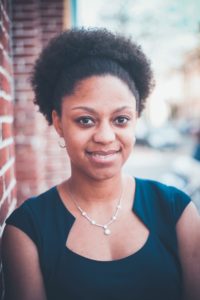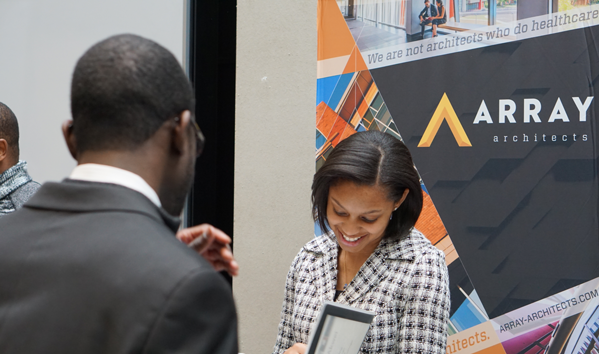The American Institute of Architecture Students (AIAS) is celebrating the 60th anniversary of student excellence in leadership, service, and design. In honor of our 60th year, the AIAS is excited to share 60th: Legacy, an ongoing weekly celebration of and thanks to our alumni sponsored by Professional Publications, Inc (PPI). PPI is a publisher of professional licensing exam materials since 1975 and wants to recognize those who have helped the AIAS achieve 60 years of success.

Name
Jennifer Matthews, Assoc. AIA
Organization
Array Architects
Title
Architectural Designer
Connect
Twitter | Instagram | LinkedIn
Bio
Jennifer T. Matthews is an Architectural Designer for Array Architects in Washington, DC, with a specialization in healthcare architecture. She is a 2013 graduate of the Tuskegee University Robert R. Taylor School of Architecture and Construction Science (TSACS) and the 2013-2014 National Vice President of the American Institute of Architecture Students (AIAS). In 2016, Jennifer was recognized as one of ten AIA Jason Pettigrew Memorial Scholarship recipients who have made significant contributions to the profession at early stages in his/her careers.
ARE Prep Tip: What is one piece of advice that you would give to those starting to test?
Give yourself the necessary, undivided attention to achieve your goal. It is okay to say no, turn down a happy hour, turn your phone off, deactivate Facebook, and simply just take some time to focus on you. You may fail, but that’s okay. If the thought of failure scares you from taking the tests, then you will never know what it feels like to succeed.

How did your experience with AIAS help you to achieve your goals?
My leadership began during undergraduate studies when I became the president of the Tuskegee University Chapter of the American Institute of Architecture Students (AIAS) and created several first-time events. This initial leadership opportunity allowed me to support my department and student body during two accreditation visits and transitions in administrative leadership. These efforts revitalized our student body’s interests and presented many avenues of success for my peers. This experience taught me that architecture is more than the buildings we see, rather the impact we are able to create through leadership. Design industries are in many cases knowledge-based communities with the ability to shape the world around us, serve underrepresented groups, and change lives. AIAS allowed me to realize my passion for serving students and providing resources for them to better achieve their goals.
After my term as AIAS Vice President, I assisted the local chapter of the National Organization of Minority Architects (NOMA) with the creation of the NOMAS symposium during the spring of 2016. My efforts have continued as my firm, Array Architects, approaches its first-time event entitled Mind the Gap , which will occur April 1st, 2017. As the immediate past president of the Tuskegee University Architecture and Construction Alumni Association (TACAA), a 501(c)3 nonprofit organization, I assisted the organization in program development efforts and emerging professional support over a two-year leadership term. The Association has hosted a successful Gofundme entitled “Pay It Forward” that allowed the awarding of multiple student scholarships each academic year. The Association also hosts a 50+ member group entitled “AREweDONEyet?!?!,” which provides a platform for Tuskegee graduates to support one another through the ARE licensure process. These among many other accomplishments serve as a continuous reminder that architecture is so much more than the buildings we design, rather the people we serve along the way that will one day become the future of their respective communities.
What is one tip you would give yourself in your 20s?
I’m still in my 20s and the best advice I can offer to myself is not to sweat the small things and don’t worry about things out of my control. During school, I was extremely concerned about getting good grades and allowing those grades to land me a good job after graduation. In between the good grades, I should have had more fun and gone to more parties. Once you get older, you tend to value peace and quiet more than parties and you might just fall asleep before the party starts.
How have you overcome unforeseen challenges through your career?
One of the larger challenges I’ve faced and continue to face is the small percentage of ethnic diversity present within the field of architecture. There are only 384 licensed female architects, and 2,097 total African American Architects, in the United States. In 2014, I had the opportunity to meet the only native american licensed architect at an AIA event. I find it troubling and a major challenge that we as a profession continue to struggle with achieving diversity in the sense of ethnicity. Instead, we are constantly provided numbers of how the profession has already and continues to achieve gender diversity, which is great but can be considered the first of many well overdue progressions towards diversity. We cannot truly say we have accomplished the meaning of diversity until all of our numbers are just as high as those of gender diversity, and I chose to assist with these challenges through much of my leadership involvement as an emerging professional.
I continue to advocate for events such as the NOMAS symposium to assist students professionally, encouraging speaking events for schools containing high percentages of minority students, attending career fairs, and maintaining a platform for which graduates from Historically Black College and University can receive support each other towards licensure. The National Organization of Minority Architects (NOMA) hosts a conference each year that attracts much or the profession’s diversity and the organization also hosts an excellent program called Project Pipeline that introduces K-12 students to architecture. These efforts must continue to grow tremendously and it takes many, many people all across the US to spread the efforts. Last, but definitely not least, I owe it to myself to get licensed so I can advocate alongside others who can call themselves architects and serve as an inspiration to many emerging professionals who seek licensure. As I continue to work my way through the process, I also find this as one of the biggest challenges I’ve faced in my career.
How do you define work-life balance and how is it achievable?
I believe work-life balance is the ability to function efficiently without strenuous and unexpected tasks interrupting your workflow and/or personal life. This can best be achieved by surrounding yourself with others who also value work-life balance and those who strive to achieve it. At Array Architects, our staff consists of mothers, fathers, spouses, professional leaders, community activists, sports enthusiasts, etc. These individuals tend to stick as close as possible to their 40 hour weeks and will decline additional work hours in order to fulfill those outer office obligations. Our firm’s leadership is supportive of family-time and often sends out firm-wide surveys to gauge employee’s thoughts on issues such as firm culture, work-life balance, employee engagement, communication, etc. My firm also offers year-round flex hours for individuals who have experienced more than 8 hour work days during the week. It’s also great to have an amazing spouse who constantly reminds you to take some time out for yourself and focus on some things you want to do and accomplish. We serve as accountability for each other and it’s very necessary to make sure you maintain your sanity in the mix of work, leadership, community involvement, and just life in general.
What is a decision or action you made in school that influenced your trajectory?
During school, I made the decision to step away from the university softball team, which was one of the scariest and boldest decisions I had ever made because I received both academic and athletic scholarships. For as long as I could remember, I always played a sport and it was hard for me to put away something that was always a part of my K-12 childhood memories. Looking back, it was one of the best decisions I ever made because it allowed me the opportunity to focus more on architecture, become a leader for the AIAS chapter, attend conferences, and just live life as a normal student for the first time in my life. It was a great feeling to explore something that was so foreign to me and in many cases it made me step outside of my comfort zone.
If you, or another AIAS alumni you know, deserves recognition for their contribution to the profession and society at large, please use the link below to nominate them for this honor.











